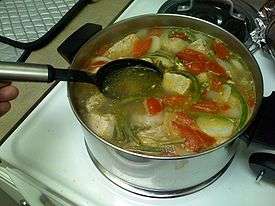Sinigang
|
A pot of tamarind sinigang | |
| Type | Soup or stew |
|---|---|
| Course | Main course |
| Place of origin | Philippines |
| Serving temperature | Hot |
| Main ingredients | Meat, vegetables, tamarind, fish sauce, onions, siling mahaba, tomatoes |
| Variations | Pork, beef, shrimp, fish, chicken |
| Other information | Can be served in many different forms |
|
| |
Sinigang is a Filipino soup or stew characterized by its sour and savoury taste most often associated with tamarind (Filipino: sampalok). It is one of the more popular viands in Philippine cuisine, and is related to the Malaysian dish singgang.
While present nationwide, sinigang is seen to be culturally Tagalog in origin, thus the versions found in the Visayas and Mindanao may differ in taste (mainly ginger is an additional ingredient). Fish sauce is a common condiment for the stew.
A one-pot meal like Beef Sinigang (Sinigang na Baka) with the ingredients of healthy choices – a vegetable that provides many nutrients including potassium, dietary fiber, vitamin A and C. While meat like beef supply nutrients that include protein, vitamin B and E, iron, zinc, and magnesium. [1]
Ingredients

Sinigang is traditionally tamarind-based. Variations of the dish derive their sourness from ingredients such as guava, calamansi, kamias, santol or unripe mango.[2] Seasoning powder or bouillon cubes with a tamarind base are commercial alternatives to using natural fruits. [3] [4] Meat in sinigang (e.g., fish, pork, beef, shrimp, or chicken) is often stewed with tamarinds, tomatoes, garlic, and onions. Other vegetables commonly used in the making of sinigang include okra, taro corms (gabi), white radish (labanós), water spinach (kangkóng), yardlong beans (sitaw) and eggplant (talóng). Most Filipinos like to cook sinigang with green long peppers in order to enhance the taste and add a little spice to the dish. Another variation includes adding locally made miso.
Sinampalukang manók or sinampalukan (from sampalok) is technically not a variation of sinigang, as the chicken has to be sautéed in ginger first instead of all the ingredients being placed simultaneously into the pot and brought to a boil. Sinampalukan is also distinguished by its use of shredded tamarind leaves, and is usually made together with ginger, onions, tomatoes, eggplant and spinach.
Sinigang variations
- Sinigáng sa Misô (Sinigang with miso added to the soup as the umami element, usually with a tamarind base)
- Sinigáng sa Bayabas (Sinigang that uses guava as the sour soup base)
- Sinigang sa Mangga (Sinigang that uses unripe mango as the sour soup base)
- Sinigang sa Kalamansi (Sinigang that uses calamansi or lemon as the sour soup base)
- Sinigáng na Isdâ (Fish Sinigang)
- Sinigáng na Baboy (Pork Sinigang)
- Sinigáng na Hipon (Shrimp or Prawn Sinigang)
- Sinigang na Baka (Beef Sinigang)
- Sinampalukang Manók (Chicken with tamarind leaves)
See also
References
| Wikibooks Cookbook has a recipe/module on |
Further reading
- Eckhardt, Robyn and David Hagerman. (2007-02-15). Why Not Sinigang?. Retrieved 2010-08-02 from the EatingAsia food blog.
- Fernandez, Doreen. (1976). Why Sinigang?. In Gilda Cordero-Fernando. The Culinary Culture of the Philippines. Manila: Bancom Audiovision Corporation. pp. 24–29.
- Perez, Irene C. (2010-07-01). Why piping-hot ‘sinigang’ is the national dish. Philippine Daily Inquirer. Retrieved 2010-08-02.
